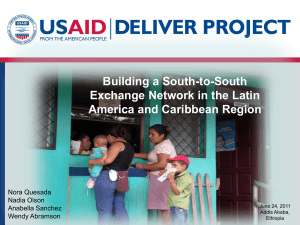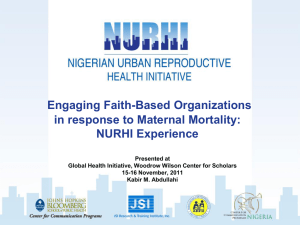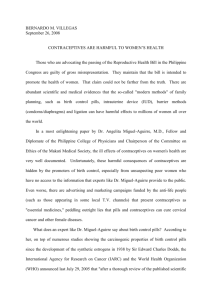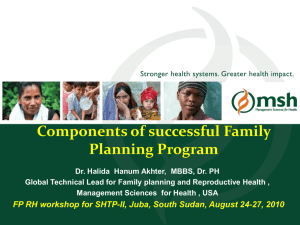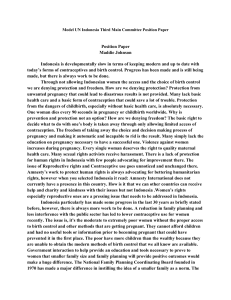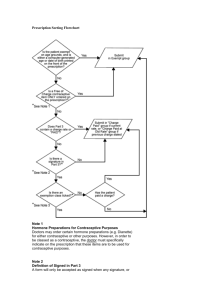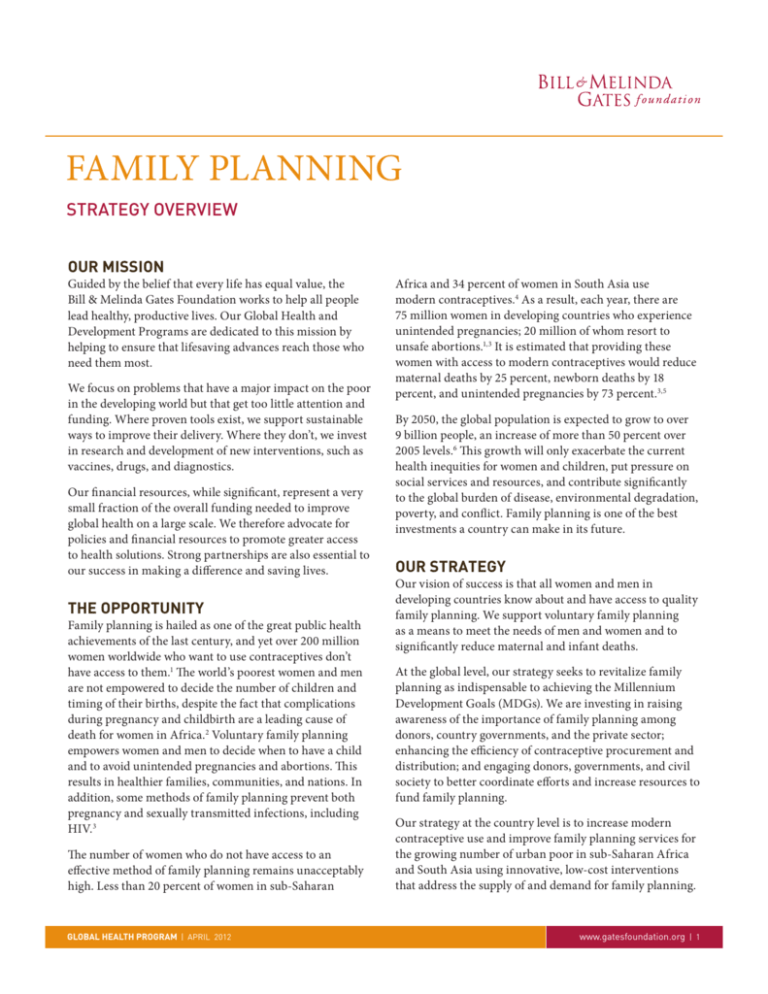
FAMILY PLANNING
STRATEGY OVERVIEW
OUR MISSION
Guided by the belief that every life has equal value, the
Bill & Melinda Gates Foundation works to help all people
lead healthy, productive lives. Our Global Health and
Development Programs are dedicated to this mission by
helping to ensure that lifesaving advances reach those who
need them most.
We focus on problems that have a major impact on the poor
in the developing world but that get too little attention and
funding. Where proven tools exist, we support sustainable
ways to improve their delivery. Where they don’t, we invest
in research and development of new interventions, such as
vaccines, drugs, and diagnostics.
Our financial resources, while significant, represent a very
small fraction of the overall funding needed to improve
global health on a large scale. We therefore advocate for
policies and financial resources to promote greater access
to health solutions. Strong partnerships are also essential to
our success in making a difference and saving lives.
THE OPPORTUNITY
Family planning is hailed as one of the great public health
achievements of the last century, and yet over 200 million
women worldwide who want to use contraceptives don’t
have access to them.1 The world’s poorest women and men
are not empowered to decide the number of children and
timing of their births, despite the fact that complications
during pregnancy and childbirth are a leading cause of
death for women in Africa.2 Voluntary family planning
empowers women and men to decide when to have a child
and to avoid unintended pregnancies and abortions. This
results in healthier families, communities, and nations. In
addition, some methods of family planning prevent both
pregnancy and sexually transmitted infections, including
HIV.3
The number of women who do not have access to an
effective method of family planning remains unacceptably
high. Less than 20 percent of women in sub-Saharan
GLOBAL HEALTH PROGRAM | April 2012
Africa and 34 percent of women in South Asia use
modern contraceptives.4 As a result, each year, there are
75 million women in developing countries who experience
unintended pregnancies; 20 million of whom resort to
unsafe abortions.1,3 It is estimated that providing these
women with access to modern contraceptives would reduce
maternal deaths by 25 percent, newborn deaths by 18
percent, and unintended pregnancies by 73 percent.3,5
By 2050, the global population is expected to grow to over
9 billion people, an increase of more than 50 percent over
2005 levels.6 This growth will only exacerbate the current
health inequities for women and children, put pressure on
social services and resources, and contribute significantly
to the global burden of disease, environmental degradation,
poverty, and conflict. Family planning is one of the best
investments a country can make in its future.
OUR STRATEGY
Our vision of success is that all women and men in
developing countries know about and have access to quality
family planning. We support voluntary family planning
as a means to meet the needs of men and women and to
significantly reduce maternal and infant deaths.
At the global level, our strategy seeks to revitalize family
planning as indispensable to achieving the Millennium
Development Goals (MDGs). We are investing in raising
awareness of the importance of family planning among
donors, country governments, and the private sector;
enhancing the efficiency of contraceptive procurement and
distribution; and engaging donors, governments, and civil
society to better coordinate efforts and increase resources to
fund family planning.
Our strategy at the country level is to increase modern
contraceptive use and improve family planning services for
the growing number of urban poor in sub-Saharan Africa
and South Asia using innovative, low-cost interventions
that address the supply of and demand for family planning.
www.gatesfoundation.org | 1
Our strategy prioritizes the creation of innovative
contraceptive technologies to satisfy the global unmet
need for high-quality and affordable contraceptives. To
gain better efficiencies in spending and healthcare delivery,
we are also investing in researching how to best integrate
family planning into existing HIV and broader maternal
and child health services and programs. Each of our main
intervention areas is described below.
INTERVENTION AREAS
Advocate for more and better use of funds and
raise the visibility of family planning
There are significant challenges in the financing and
procurement of contraceptives—high price of quality midto long-acting contraceptives; volatile and unpredictable
donor funding; uncoordinated and antiquated global
procurement processes. The challenges create inefficiencies,
add to costs, and lead to stock-outs of contraceptives,
wastage of products, poor management of in-country
supply chains, and variable product quality.
Our strategy aims to address these challenges by
discovering and developing new contraceptive technologies
that meet women’s needs, advocating for increased funding
for family planning, better coordination among donors and
governments to deliver products, and enhanced efficiency of
contraceptive procurement and delivery. Our investments
to support these goals include the following initiatives:
•advocacy for funding and improved policy commitments
at all levels of national governments, among bilateral and
multilateral donors, and from the private sector
•strengthening the capacity of civil society organizations
to promote family planning
•advocacy for the integration of family planning and HIV
with the Country Coordinating Mechanisms for the
Global Fund to Fight AIDS, Tuberculosis and Malaria
(Global Fund)
•conducting an economic analysis of the return on
investment of family planning expenditures on policy
goals such as the MDGs
Increase the use of contraceptives in urban
areas among the poor and vulnerable
In 2008, the urban share of the world’s population reached
50 percent for the first time.7 It is predicted that most future
global population growth will occur in towns and cities in
developing countries. In particular, urban populations in
Africa and South Asia—the most rapidly growing regions
in the world—are projected to double between 2000 and
2030.7 Urban births are concentrated among the poorest
GLOBAL HEALTH PROGRAM | April 2012
populations; a significant number of these births are
unintended; and the maternal, infant, and reproductive
health status of the urban poor is comparable to—or worse
than—that of rural residents.8
Our strategy focuses on enhancing the delivery of family
planning services to people living in impoverished urban
areas. Our main investment in this area is the Urban
Reproductive Health Initiative, which aims to provide
high-quality, cost-effective, and voluntary family planning
services to some of the world’s most vulnerable people—the
urban poor of Asia and sub-Saharan Africa. The initiative
harnesses the private sector and demand channels while
linking country-level implementation teams in India (Uttar
Pradesh), Nigeria, Kenya, and Senegal to identify and
share the most effective approaches for meeting the family
planning needs of the world’s urban poor. The initiative
also has a strong measurement and evaluation component
to ensure data-driven implementation, rigorous evaluation,
strengthened approaches related to equity, and widespread
sharing of evidence to scale up and replicate findings.
Develop innovative contraceptive technologies
There are many reasons why women do not use
contraceptives even when they want to avoid pregnancy.
Some women have misperceptions about their risk of
becoming pregnant, while others have concerns about the
side effects of modern contraceptive methods. In some
cases, opposition from husbands or family members may
discourage contraceptive use. Lack of access to an adequate
mix of modern contraceptives is another barrier.9
Our objective is to address barriers to nonuse and accelerate
the uptake of contraceptives in sub-Saharan Africa and
South Asia through the discovery and development of new
technologies.
We are now investing in the quality assurance, regulatory
approval, and careful introduction of two products in
selected countries of sub-Saharan Africa and South
Asia. The first is Sino-implant (II)®, by Shanghai Dahua
Pharmaceuticals in China. Sino-implant (II) is a longacting, effective, and low-cost implant that is now registered
in 20 developing countries. Efforts are now underway to
finalize the prequalification of this product, negotiate public
sector price ceiling agreements, work with distributors
to secure regulatory approvals, and provide technical
assistance for its introduction in various countries.
The second product is depo-subQ provera 104®in the
Uniject™ injection system (DMPA-subQ in Uniject), a
new subcutaneous presentation of the popular injectable
contraceptive depot medroxyprogesterone acetate (DMPA,
www.gatesfoundation.org | 2
brand name Depo-Provera®). Currently, DMPA is delivered
through intramuscular injection, necessitating a health
worker to provide the method in most countries. The new
DMPA-subQ in Uniject, which is manufactured by Pfizer,
has the potential to be delivered by nonmedical providers,
such as trained community health workers, and possibly
by women themselves. Implants and DMPA are especially
popular in sub-Saharan Africa, and we are hopeful that
these new methods can increase coverage and use of
family planning. Efforts are now underway to assess the
training, systems, policies, and infrastructure necessary to
sustainably implement DMPA-subQ in Uniject.
Additional contraceptive methods are needed to address
the diverse needs of communities around the world. We are
investing in additional products that we hope will meet the
needs of women and couples. These investments include
an on-demand oral contraceptive pill, the Nestorone®ethinylestradiol vaginal ring, a 6-month injectable, and
potential innovations in nonhormonal methods and
nonsurgical female sterilization.
Close key knowledge gaps in family planning
There remain several critical knowledge gaps related to
increasing access to family planning. Our strategy supports
investments to address these gaps by conducting intensive
research and development to:
•test models for integrating family planning with HIV
prevention and care services to increase access to family
planning among HIV-positive men and women
•determine whether the integration of family planning
into maternal and child health, HIV, postpartum, and
post-abortion services results in a significant increase in
modern contraceptive use
•Obtain more definitive data on HIV acquisition with
the use of hormonal contraceptives to inform policy and
program implementation
PROGRESS
Our partners have had some successes in strengthening
donor contributions and coordination affecting
contraceptive supply. Some examples of this include:
•In September 2010, the Alliance for Reproductive,
Maternal and Newborn Health was launched to accelerate
progress toward MDGs 4 and 5. U.S. Secretary of State
Hillary Clinton, UK Deputy Prime Minister Nick Clegg,
Australian Minister Kevin Rudd, and Melinda Gates,
co-chair of the Gates Foundation, launched the alliance at
the United Nation’s Summit on the MDGs. During its first
year, the alliance focused on forging effective partnerships
GLOBAL HEALTH PROGRAM | April 2012
and improving family planning programs in 10 high-need
countries in sub-Saharan Africa and South Asia.
•The Reproductive Health Supplies Coalition grew from
18 member organizations to over 100 members, which
coordinate donors and address the fundamental technical
and advocacy issues regarding contraceptive supplies.
•In February 2011, donors jointly funded the Francophone
West Africa Conference—Population, Development
and Family Planning conference in Burkina Faso,
which was attended by nine country delegations that
included ministers of health, finance, and planning. Each
of the country delegations presented action plans for
strengthening their national family planning programs
and policies. At the meeting, the Government of France
pledged €450 million (euros) over the next five years in
support of MDGs 4 and 5 in West Africa with a focus on
family planning.10
•In Uganda, a policy prohibiting community health
workers from providing injectable contraceptives was
reversed.11 Another policy change allowed NGOs to access
contraceptives from the central warehouse of the National
Medical Stores.12
•In late November 2011, more than 2,200 participants came
together for the historic Second International Conference
on Family Planning, the largest ever to focus on family
planning. The participants represented 88 countries,
and included researchers, program managers, clinicians,
parliamentarians, policy makers, and journalists. The
conference drew top-tier political commitment including
the President of Senegal’s pledge to commit an additional
$1 million (U.S.) for contraceptives in Senegal, and DFID’s
pledge of an additional 40 million pounds for global
commodity security.
CHALLENGES
A large challenge to our work in family planning is that the
global community, including both private and public sector
stakeholders, is still not sufficiently galvanized to fund
family planning to meet the unmet need for contraceptives
among women in sub-Saharan Africa and South Asia.
Governments and other donors are focused on other health
priorities, and family planning is competing for scarce
monetary and human resources at the country and global
levels. We are working hard to hold national governments
and the global donor community accountable for their
pledges to improve family planning by communicating
the importance of voluntary family planning in reducing
maternal and child deaths, enhancing the livelihood of
women, and reducing poverty.
www.gatesfoundation.org | 3
Shortages of contraceptives are a major challenge that
undermines our country programs’ ability to achieve
results. We are funding an in-depth assessment to assess
the strengths, limitations, and performance gaps within
the contraceptive supply chain to allow for a deeper
analysis of forecasting, financing, procurement, inventory
management, and distribution of contraceptives in both the
public and private sectors.
Another challenge is that some current contraceptives
remain too costly for procurement groups and in some
cases, for the women who use them. In the area of implants,
we have begun discussions with manufacturers to address
the high cost of implants, and the potential for volume
purchases and price reductions for developing countries.
We are also helping manufacturers in developing countries
gain prequalification from the World Health Organization
in order to expand the market and allow for more
competition and low-cost options for procurement groups.
WORKING TOGETHER
Reaching the millions of women and couples who desire
effective family planning methods requires the dedication
of all of our government, donor, private sector, research,
nongovernment, and community partners. Because our
resources are limited in relation to what is needed to
address the unmet need for family planning globally, we
work closely with existing and emerging donors to ensure
that funds are spent well, improve policies, enhance the
efficiency of procurement and delivery of services, and
ultimately, to save and improve lives.
TO LEARN MORE
About the Global Health Program:
www.gatesfoundation.org/global-health
About Family Planning:
www.gatesfoundation.org/familyplanning
REFERENCES
1.Singh, S., J. Darroch , L. Ashford, and M. Vlassoff. 2009. Adding It Up:
The Costs and Benefits of Investing in Family Planning and Maternal
and Newborn Health. New York: Guttmacher Institute and United
Nations Population Fund.
2.World Health Organization. 2004. Maternal Mortality in
2000: Estimates developed by WHO, UNICEF, and UNFPA.
Geneva, WHO. www.who.int/reproductivehealth/publications/
monitoring/9241562706/en/index.html.
3.Guttmacher Institute. 2010. Facts on Investing in Family Planning and
Maternal and Newborn Health. In Brief. www.guttmacher.org/pubs/
FB-AIU-summary.pdf.
4.Population Reference Bureau. 2011. Datafinder [online database]. www.
prb.org/DataFinder.aspx.
5.Finkle, C. Unpublished. Data analysis based on private communications
with Jacqueline E. Darroch and Susheela Singh, Guttmacher Institute,
August 2011.
6.United Nations. 2008. World population to exceed 9 billion by 2050
[press release]. www.un.org/esa/population/publications/wpp2008/
pressrelease.pdf.
7.United Nations Population Fund (UNFPA). 2007. State of the world
population 2007: Unleashing the Potential of Urban Growth. www.
unfpa.org/swp/2007/presskit/pdf/sowp2007_eng.pdf.
8.Ezeh, A. 2008. Population growth, poverty and reproductive health:
Revisiting the urban advantage. Paper presented at the Foundation
Presidents Meeting.
9.Guttmacher Institute and International Planned Parenthood
Federation. 2010. Facts on Satisfying the Need for Contraception in
Developing Countries. In Brief. www.guttmacher.org/pubs/FB-UnmetNeed-Intl.pdf.
10.United States Agency for International Development (USAID). 2011.
Population, development, and family planning in Francophone West
Africa: The Urgency for Action [Conference summary]. www.usaid.
gov/our_work/global_health/pop/news/popdev_confoutcome.pdf.
11.Johns Hopkins Bloomberg School of Public Health and Advance
Family Planning. 2011. Taking Injectable Contraceptives to
Villages: An Advocacy Case Study in Uganda [case study]. www.
advancefamilyplanning.org/system/files/Uganda%20CBD%20Case%20
Study%2010%2018%202011%20FINAL.pdf.
12.Johns Hopkins Bloomberg School of Public Health and Advance Family
Planning. 2011. Dramatic Increases in Access to Family Planning
Commodities: An Advocacy Case Study in Uganda [case study]. www.
advancefamilyplanning.org/system/files/NMS%20Case%20Study%20
FINAL.pdf.
Guided by the belief that every life has equal value, the Bill & Melinda Gates Foundation works to help all people lead healthy, productive lives. In developing
countries, it focuses on improving people’s health and giving them the chance to lift themselves out of hunger and extreme poverty. In the United States, it seeks
to ensure that all people—especially those with the fewest resources—have access to the opportunities they need to succeed in school and life. Based in Seattle,
Washington, the foundation is led by CEO Jeff Raikes and Co-chair William H. Gates Sr., under the direction of Bill and Melinda Gates and Warren Buffett.
For additional information on the Bill & Melinda Gates Foundation, please visit our website: www.gatesfoundation.org.
© 2012 Bill & Melinda Gates Foundation. All Rights Reserved. Bill & Melinda Gates Foundation is a registered trademark in the United States and other countries.
GLOBAL HEALTH PROGRAM | April 2012
www.gatesfoundation.org | 4

